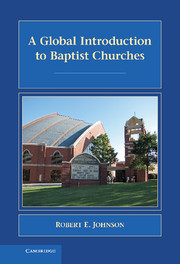Book contents
- Frontmatter
- Contents
- List of Illustrations
- Acknowledgments
- List of Important Baptist Organizations
- Global Baptist Timeline
- Introduction
- PART I FOUNDATIONS
- PART II AGE OF EMERGING BAPTIST DENOMINATIONAL TRADITIONS
- PART III THE FRONTIER AGE
- PART IV AGE OF PROLIFERATING TRADITIONING SOURCES
- PART V BELIEFS AND PRACTICES
- Index
PART II - AGE OF EMERGING BAPTIST DENOMINATIONAL TRADITIONS
Global Baptist Development Phase 1, 1600–1792
Published online by Cambridge University Press: 05 September 2012
- Frontmatter
- Contents
- List of Illustrations
- Acknowledgments
- List of Important Baptist Organizations
- Global Baptist Timeline
- Introduction
- PART I FOUNDATIONS
- PART II AGE OF EMERGING BAPTIST DENOMINATIONAL TRADITIONS
- PART III THE FRONTIER AGE
- PART IV AGE OF PROLIFERATING TRADITIONING SOURCES
- PART V BELIEFS AND PRACTICES
- Index
Summary
Trusting that we have through the power of Divine Grace, been enabled to yield ourselves up to God: So we do now covenant with each other, looking up to the great Head of the church for assistance in fulfilling our most solemn engagements. That we will by the grace of God; walk with each other in humility and brotherly love. Watching with Christian candor and care over each other for good, warning, rebuking, admonishing each other in love according to the gospel: and will ever strive to stir up each others [sic] minds to love and good works. That we will try to maintain the character of a Christian family, participating in each others [sic] joys and with tenderness and sympathy bearing each others burdens and sorrows. That we will respect our aged brothers and sisters and as far as we have opportunity, we will comfort them in their declining age.
Chief Charles Journeycake, Pastor, Portions of the “Covenant,” Original Minutes of the Delaware Baptist Church, 1871A BAPTIST PROFILE
In September 1769, about two years before his death, Shubal Stearns, a charismatic Separate Baptist preacher and founder of the rapidly growing center of Baptist work in Sandy Creek, North Carolina, had a troublesome dream. When climbing a hill near his home, he saw clouds on the horizon that appeared as though a heap of snow. Approaching the cloud, “he perceived the heap to stand suspended in the air 15 to 20 feet above the ground. Presently it fell to the ground and divided itself into three parts; the greatest part moved northward; a less towards the south; and the third, which was less than either but much brighter, remained on the spot where the whole fell.” As the clouds slowly vanished, Stearns instinctively sensed that this was a message to him about the future.
- Type
- Chapter
- Information
- A Global Introduction to Baptist Churches , pp. 51 - 52Publisher: Cambridge University PressPrint publication year: 2010



